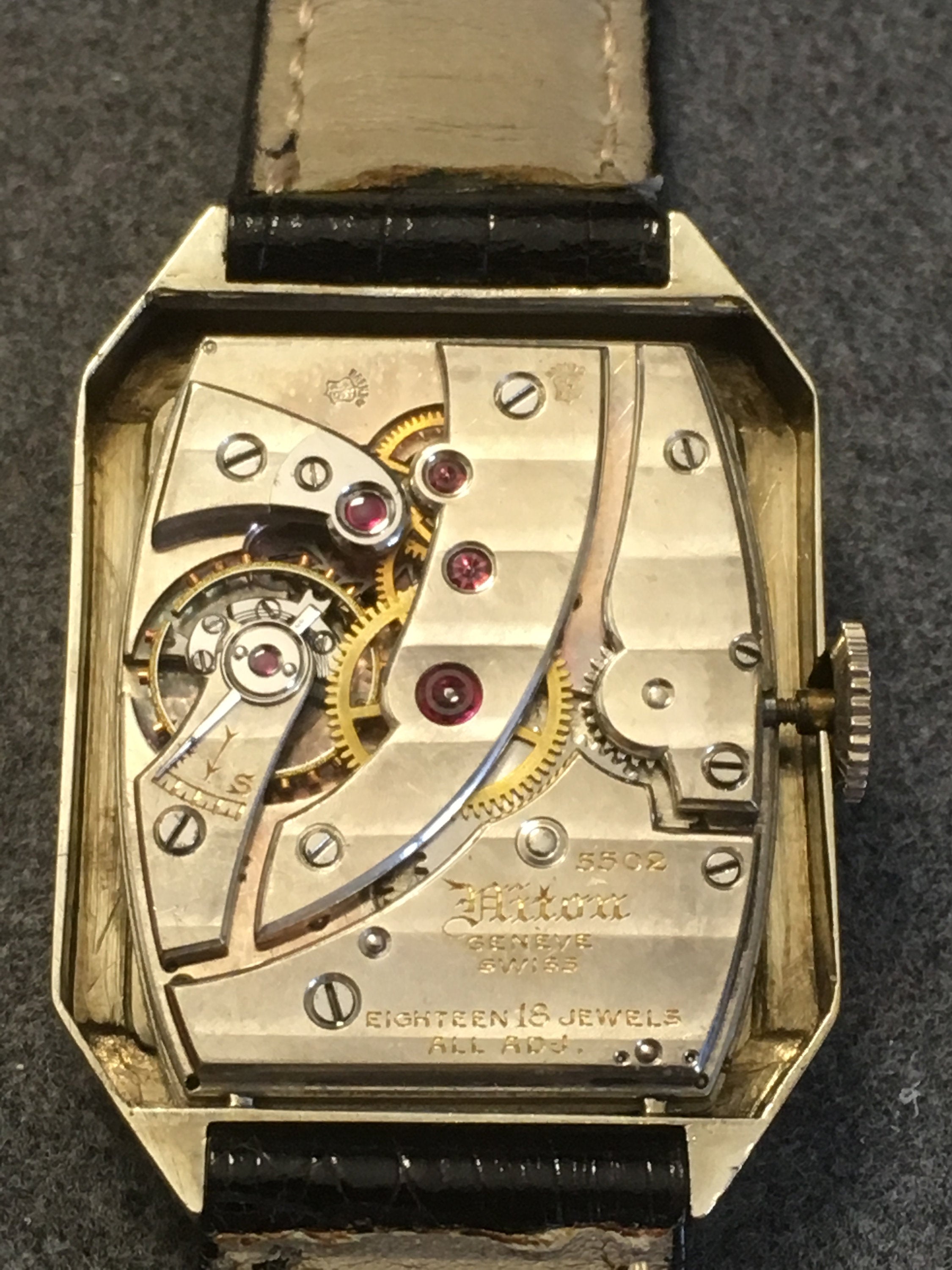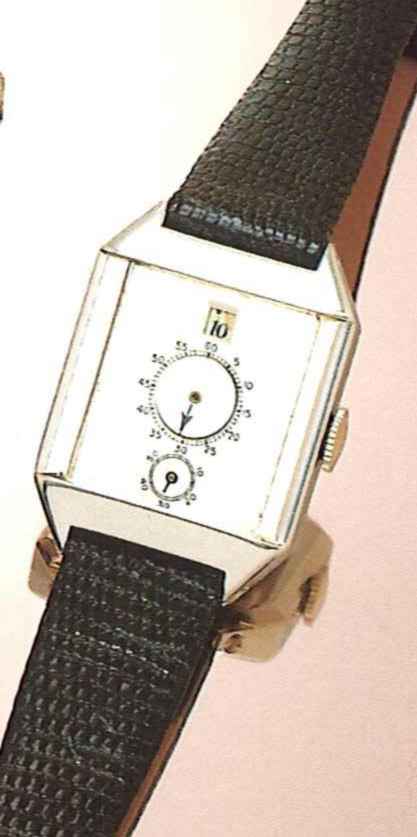Watch Data
18k white gold Wrist Chronometer no. 5502
Case: 18k white gold tonneau/rectangular shaped case, caseback stamped "Niton, Geneve, Switzerland" with case maker's mark 334 in a hammer head which refers to Ponti, Gennari & Cie.
Dial: Silvered, jump hour, revolving minute disc, subsidiary seconds dial.
Movement: s/n; 5502, caliber 10TS, bi-metallic balance with blued steel balance spring with Breguet overcoil with polished steel kidney piece, signed "Niton, Geneve, Swiss, Eighteen 18 jewels, all adj, 5502", stamped with the Geneva seal. The movement obtained the Poincon de Geneve quality seal on January 11, 1929 and was part of a batch of 12 (5744-5504).
Provenance:
1929 - Niton, Geneve
1990 - Antiquorum
2018 - Sotheby's
2021 - Bonhams, Hong Kong
Antiquorum, 14 Oct 1990 est 12-16,000chf sold 15,525CHF "Niton, Genève, No. 5502, 1920's. Extremely fine and rare, octagonal, jumping-hour, 18 et white gold gentleman's wristwatch. C. massive, polished. D. mat silver, aperture for the jumping-hours at the top, revolving disc for the minutes at the centre, below, the seconds dial, with painted Arabic numerals, "Flèche", blued steel hands. M. 8 1/2", tonneau, Geneva Quality Hall Mark, rhodiumed, "fausses-côtes" decoration, 18 jewels, lever escapement, cut bimetallic balance adjusted to heat, cold, isochronism and 5 positions, Breguet balance-spring. Case and movement signed. In very good condition. Dim. 24 x 32 mm. C. massive, polished. D. mat silver, aperture for the jumping-hours at the top, revolving disc for the minutes at the centre, below, the seconds dial, with painted Arabic numerals, "Flèche", blued steel hands.
M. 8 1/2", tonneau, Geneva Quality Hall Mark, rhodiumed, "fausses-côtes" decoration, 18 jewels, lever escapement, cut bimetallic balance adjusted to heat, cold, isochronism and 5 positions, Breguet balance-spring. Case and movement signed. In very good condition. Dim. 24 x 32 mm."
2000 - Antiquorum, Geneva 19 Nov 2000, lot 50, est 18-20,000chf unsold, "Niton Genève. Produced in the 1920's.Very fine and elegant rectangular, jump hour, 18K white gold gentleman's wristwatch. C. two-body, solid, polished, pyramidal lugs, gold bars. D. matte silver with painted Arabic numerals for the minutes and the seconds, aperture for the jump hour. 'Flèche' blued steel hands. M. Cal. 5502, 9''', stamped with the Geneva Quality Hallmark, tonneau, rhodium plated, 'fausses côtes' decoration, 18 jewels, lever escapement,cut bimetallic balance, all adjustments, Breguet balance spring.Signed on the movement, numbered on the case.Dim. 24 x 33 mm. C. two-body, solid, polished, pyramidal lugs, gold bars. "
2018 - http://www.sothebys.com/en/auctions/ecatalogue/2018/fine-timepieces-online-ge1811/lot.130.html locale=en">Sotheby's 15 Mar 2018 est 1500-3000chf sold 4500chf "Niton A WHITE GOLD RECTANGULAR JUMPING HOUR WRISTWATCH CASE 10186 MVT 5502 CIRCA 1930 manual winding lever movement, 18 jewels • silvered dial, aperture for hours, rotating disk for minutes, subsidiary seconds • 18k white gold rectangular case, snap-on back, movement signed length 32.5mm (including lugs)"
2019 - Etsy $12,000 "Niton, Genève, circa 1920's The present watch you are viewing is a very rare & very sought out Niton Jump Hour from the 1930s. Niton was commisioned by the likes of Patek Philippe, Cartier, Lange & Sohne to the name a few. Niton were masters in creating jump hour movements and especially blossomed during the 1930s when Jump complicated wristwatches became especially popular.
The Manufacture Niton was founded on October 28, 1919 in Geneva as “Societé Collectiv Jeannet, Morel and Bourquinâ€, in the rue de Montblanc 19th partners were William- August Jeannet from Le Ponts de Martel, Edouard- Henri Morel from Geneva and Achille Alfred Bourquin from Bern, Morel & Borquin were both first active at Vacheron Constantin. On the first of December, the man moved to Rue de La Servette on the other side of the station 24. On October 10, 1922, the company renamed the Manufacture de montres Niton. A fourth partner joined the company in 1922, but the latter, called Samuel Raymond, left on November 12, 1933. In 1927, William- August- Jeanneret left the company and the company headquarters were relocated to “Rue du Stand 30â€. In 1928, the company received first place for a pocket watch at the chronometer competion. It is noteworthy that one of the first wristwatches by A. Lange & Söhne was equipped with a work by Niton Among others with Niton caliber 5711
Extremely Fine and Rare, Octagonal, Jumping-Hour, 18 KT White Gold Gentleman's Wristwatch.
Mat silver, aperture for the jumping-hours at the top, revolving disc for the minutes at the centre, below, the seconds dial, with painted Arabic numerals, "Flèche", blued steel hands. M. 8 1/2", tonneau, Geneva Quality Hall Mark, rhodiumed, "fausses-côtes" decoration, 18 jewels, lever escapement, cut bimetallic balance adjusted to heat, cold, isochronism and 5 positions, Breguet balance-spring. Case and movement signed, In very good condition.
Dimensions: length 32.5mm (including lugs)
Dim. 24 x 32 mm.
The present lot sold for $15,525 CHF in the year 1990, lot 199
Additional Details about The Jump Hour Complication
As a brief introduction, a jumping hour watch is one that does not feature a traditional hour hand that sweeps the dial once every 12 (or 24) hours, but instead has a disc viewed through an aperture on the dial that jumps to display the next hour precisely as the minute hand reaches 60 minutes. The correlation between the earth’s rotation during a day and an hour hand slowly arcing round the dial sits well with our common model of displaying time, but a jumping hour watch plays on the way mankind has broken up the day into discrete hour chunks. The inclusion of an hour hand in continuous motion gives an easy visual representation of the relative position between the previous hour and the next one, whereas the jump hour aperture gives an explicit bookend between the end of one hour and the start of another. The combination of digital and analog displays is utilized to convey the time here.
Many famous clockmakers were experimenting with “wandering hours†in the 18th century and Josef Pallweber later patented his design for a pocket watch with jumping hours and minutes in 1883. His design was licensed to IWC amongst others, but the boom for jumping hour watches didn’t really come about until the 1920s and coincided with the Art Deco movement. The complication fell out of fashion and remained so until the 1970s when the jumping hour made something of a comeback in both mechanical and quartz form. Many of the cheaper examples from this period are actually direct read watches comprising discs for hours, minutes and seconds that are all in constant motion but viewed through windows so that only the relevant part of each disc is shown.
The art of the complexity of creating a jump hour movement is the regulation of power that is transferred to the hour disc. Unlike a traditional time display which uses a constant force regardless of position of the minute or hour hands, the “snap†of a jumping hour only needs a delivery power for a short period each hour when the mechanism engages.This sudden spike in required power potentially reduces the amplitude of the balance for the rest of the movement at this time, or increases it for the rest of the hour when no additional power is needed. A further potential problem to wearers is the precision with which the jump occurs; a slow or imprecise date change is forgivable to most people, but seeing the minute hand registering somewhere between 59 and 1 minutes during a jump would not be so easy to live with.
Solving these kinds of problems is usually the playground of high-end watchmakers—who often revel in doing such things just to show they can—which goes some way to explaining the limited choice for jumping hour watches especially when looking for one in the 1920's which is completely original and at a time where this complication begins to show up on the wristwatch and transition from its presence on the pocket watch."
Sotheby's
Bonhams - LOT 837, Hong Kong Watches, 1 Dec 2021, 14:30 HKT, Hong Kong, Admiralty
NITON, GENEVE | JUMP HOUR, A VERY ATTRACTIVE 18K WHITE GOLD DIGITAL JUMP HOUR WRISTWATCH, CIRCA 1935.
Property of a Japanese Collector
NITON, GENEVE | JUMP HOUR, A VERY ATTRACTIVE 18K WHITE GOLD DIGITAL JUMP HOUR WRISTWATCH, CIRCA 1935
Movement No: 5502
Case No: 10186
Calibre: Manual winding, double stamped with the Geneva seal, signed
Dial: Silvered
Case: Length including lugs 33mm, 18k white gold, snap on case back, signed
Strap: Leather with stainless steel buckle
Footnotes
Niton, Geneve,「Jump Hourã€
https://www.bonhams.com/auctions/27056/lot/837/
|





|
|
